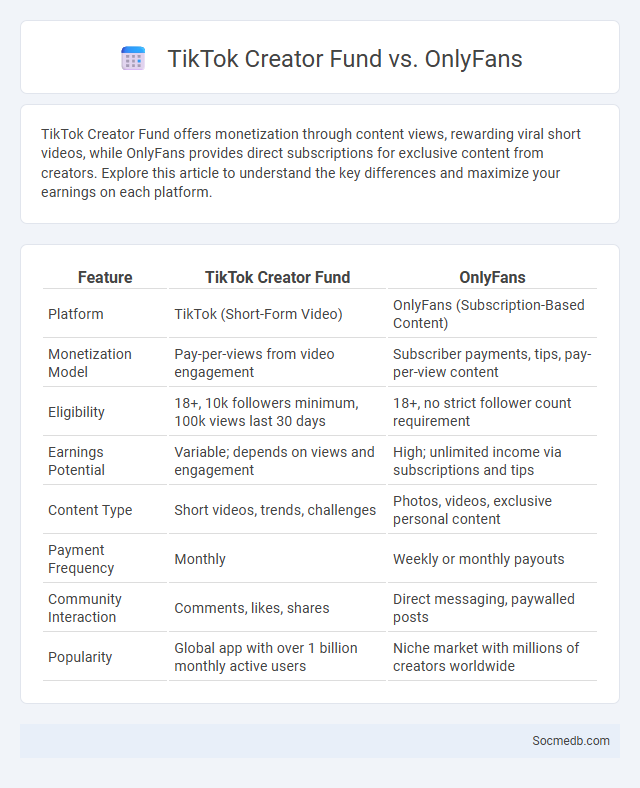
Photo illustration: TikTok Creator Fund vs OnlyFans
TikTok Creator Fund offers monetization through content views, rewarding viral short videos, while OnlyFans provides direct subscriptions for exclusive content from creators. Explore this article to understand the key differences and maximize your earnings on each platform.
Table of Comparison
| Feature | TikTok Creator Fund | OnlyFans |
|---|---|---|
| Platform | TikTok (Short-Form Video) | OnlyFans (Subscription-Based Content) |
| Monetization Model | Pay-per-views from video engagement | Subscriber payments, tips, pay-per-view content |
| Eligibility | 18+, 10k followers minimum, 100k views last 30 days | 18+, no strict follower count requirement |
| Earnings Potential | Variable; depends on views and engagement | High; unlimited income via subscriptions and tips |
| Content Type | Short videos, trends, challenges | Photos, videos, exclusive personal content |
| Payment Frequency | Monthly | Weekly or monthly payouts |
| Community Interaction | Comments, likes, shares | Direct messaging, paywalled posts |
| Popularity | Global app with over 1 billion monthly active users | Niche market with millions of creators worldwide |
Understanding the TikTok Creator Fund
The TikTok Creator Fund is a program designed to financially reward content creators based on video views, engagement, and authenticity, providing a direct income source for original content. Your eligibility depends on meeting specific criteria such as being 18 years or older, having a minimum follower count, and consistently producing content that complies with TikTok's community guidelines. By understanding how the Creator Fund calculates payments, you can optimize your content strategy to maximize earnings and grow your presence on the platform.
What Is OnlyFans and How Does It Work?
OnlyFans is a subscription-based social media platform that allows content creators to monetize their exclusive photos, videos, and live streams by charging followers a monthly fee. Users can access personalized content while creators retain control over their subscription prices and interaction with fans. The platform supports diverse content genres but is especially popular for adult entertainment, offering direct financial engagement between creators and subscribers.
Introduction to Other Creator Funds
Other creator funds provide alternative revenue streams for content creators on social media platforms beyond traditional monetization methods. These funds often distribute financial support based on engagement metrics, content quality, and platform-specific criteria, encouraging diverse and innovative content creation. Participation in such programs can enhance visibility and generate sustainable income for creators across various digital ecosystems.
Revenue Models Compared: TikTok vs OnlyFans vs Creator Funds
TikTok generates substantial revenue through in-app advertisements and brand partnerships, while OnlyFans primarily earns from subscription fees and pay-per-view content, offering creators direct monetization opportunities. Creator Funds, often used on platforms like TikTok and YouTube, allocate payments based on engagement metrics, incentivizing content that drives views and interaction. Understanding these distinct revenue models helps you optimize earnings by leveraging platform-specific monetization strategies.
Eligibility Criteria for Each Platform
Each social media platform sets specific eligibility criteria to ensure appropriate user participation and content relevance. Common requirements include minimum age limits, typically 13 or 16 years, verified identity, and compliance with community guidelines to maintain platform safety and integrity. Understanding these criteria helps you select the right platform tailored to your needs and ensures seamless account setup and engagement.
Payment Structures and Payout Rates
Social media platforms employ diverse payment structures, including fixed salaries, ad revenue shares, and performance-based incentives to monetize user engagement effectively. Payout rates vary significantly across platforms, with YouTube offering creators approximately 55% of ad revenue, while TikTok's Creator Fund distributes payments based on video views and engagement metrics. Understanding these payment mechanisms is crucial for influencers and content creators aiming to maximize earnings within competitive digital economies.
Content Ownership and Rights
Content ownership on social media platforms is typically governed by the platform's terms of service, which often grant users a license to share their content while allowing the platform to use, reproduce, and distribute it. Users should carefully review these agreements to understand their rights regarding content control, especially concerning intellectual property protections such as copyrights and trademarks. Protecting content rights involves watermarking, licensing agreements, and monitoring unauthorized use to maintain ownership claims and enforce legal actions if necessary.
Audience Reach and Engagement Potential
Social media platforms offer unparalleled audience reach, enabling brands to connect with billions of users worldwide across demographics and interests. High engagement potential arises from interactive features such as comments, shares, and live streaming, which foster real-time communication and community building. Optimizing content for algorithms and user preferences significantly boosts visibility and increases meaningful interactions, driving brand awareness and customer loyalty.
Pros and Cons of Each Monetization Method
Social media monetization methods vary widely, each with distinct pros and cons that impact your revenue potential and audience engagement. Influencer marketing offers lucrative brand partnerships but often depends on consistent follower growth and authenticity, while ad revenue from platforms like YouTube provides passive income but fluctuates with algorithm changes and viewer retention. Subscription models ensure stable income through dedicated supporters yet may limit audience reach, whereas merchandise sales grant creative control but require upfront investment and inventory management.
Choosing the Right Platform for Your Creative Business
Selecting the right social media platform for your creative business depends on your target audience, content style, and marketing goals. Visual creatives thrive on Instagram and Pinterest, while video-focused brands may find TikTok and YouTube more effective for engagement. Analyzing platform demographics and engagement metrics ensures your efforts yield maximal brand visibility and customer interaction.
 socmedb.com
socmedb.com